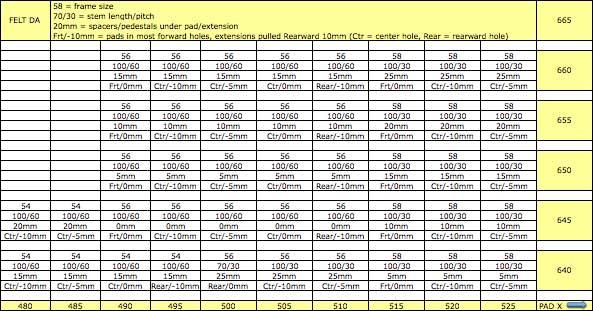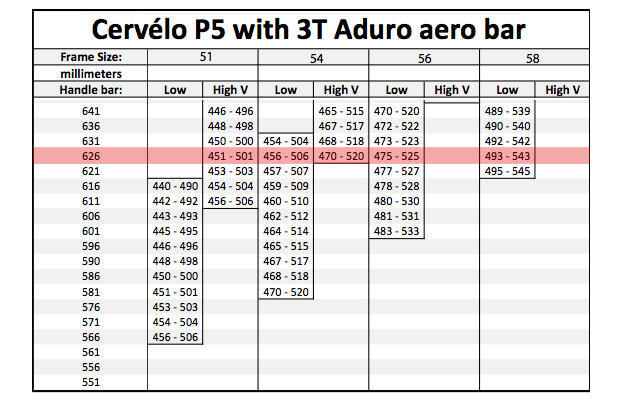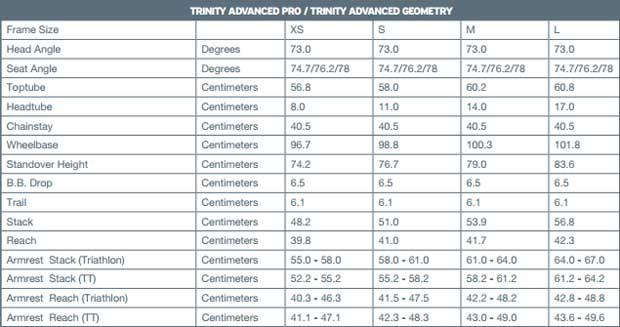No System No Sale
Most of the 34 upcoming Slowtwitch Road Shows will feature one or both of two workstations, pumping all day long.
One is a quick-change saddle demo station, to quickly determine which saddles are candidates (if not out the outright winner) and which saddles are excluded from consideration.
The other is the unsexily-named Complete Bike Solver workstation. What we do is math out for you a list of bikes that would work for your existing rider position (or one we'll hastily generate for you aboard a fit bike).
We can do this quickly – 30 minute appointments – because we already have systems (F.I.S.T. and its offspring) that can prescribe bikes that match your riding position in granular detail: the size and model of a bike and every aspect of its handlebar and front end. The engines for this are a calculator that solves the x and y dimensions from the handlebar clamp back to the head tube top of a bike we're looking for, and then our Stack and Reach tables.

Superbikes foil the attempt to use these solving calculators because we don't know the geometry of (say) a Speed Concept mid/far stem. Trek's engineer Carl Matson solved the problem on his own: a simple-to-use solving matrix for his Speed Concept's bikes. The user or the fitter identifies the height and length (y and x) from the bottom bracket to the center-top of his aerobar armrest pad. Then you look up the complete bike solution on a chart, which can be fancy or it can be an Excel Spreadsheet. Carl's motif was simple, elegant and powerful. Every superbike maker copied what Carl did.
Well, not every superbike maker, and this is a problem. I have spoken to a number of brand managers who have no solution to matching a prospective customer's bike position to their superbikes. This is a head scratcher because making a superbike solver is a 1-day task. How is it done?
First you need one root bike. Any bike. Any size. Let's take a Felt DA, size 56cm, with Felt's handlebars an one of Felt's 1-piece stems (any of its stems). Stick this bike on a trainer, level it, measure x and y from the BB to the armrest. Accurately.

Felt doesn't much traffic in the DA anymore, all its tri business pushed to the IA, but at the end of the DA's tenure there were a half-dozen one-piece stems available for that bike. If the 56cm DA you put on the trainer measures up as having a pad height (y) of 610mm and length (x) of 515mm I can tell you it's configuration:
That bike will have Felt's 90mm flat stem, 20mm of pedestals under the armrests in what I've termed its default fore/aft configuration. How do I know this? Because the Felt DA was the first bike I used when devising this process I'm describing here. I built this solver several years ago, based on Carl Matson's excellent brainstorm for the Speed Concept. Above is a screenshot of a detail of that spreadsheet I made.
I tell superbike makers to set up a spreadsheet, starting with a y-axis measure of 500mm and an x-axis of 400mm, each cell up and out from this starting point increasing in 5mm increments.
By doing what I recommend above, you have the first cell solved in this superbike solver. You know the configuration of the bike set up to give you a pad y and x of 610mm and 515mm. How many other cells can you fill in?

Well, 4 more, for starters, because this front end could conceivably be placed on each of 5 bike sizes, and if you know the stack and reach of each frame you know how the frames differ in their heights and lengths.
I ask superbike makers how their bikes adjust in the front. Felt has a number of stems. I asked Felt, “Can you tell me the height and length (the y and x) of your stems?” According to my archives the various stems they made were termed:
100/30
100/60
70/30
70/60
90/0
110/0
(The x and y of these stems didn't always exactly measure according to their names.)
If my root Felt DA measured 610mm and 515mm with a 90/0 stem and 20mm of pedestals, if I put an 100/30 stem on it with no pedestals underneath, the pads must now sit in the 620mm y-axis cell. Yippee! Another spreadsheet cell populated in my solver!
Felt's aerobar pedestals have no length component to them; they impact only the height. For all of Felt's stems if I place 5mm, and 10mm, pedestals under the pads, I can populate the next 2 cells above the unpedestaled solution.
It's kind of fun. it's addictive. The goal is to populate all the cells you can, finding a configuration that populates empty cells. Eventually all the cells are filled. Your superbike solver is built.
The Felt DA's handlebars handled fore/aft adjustment by pads that mounted on aerobar extensions, these extensions moving fore and aft in the clamp; and the pads could be affixed in rear, center, or forward holes. I created a nomenclature for this, and this is the Felt I would ride:
Size = 56
Stem = 100/30
Pedestals = 15mm
Aerobar fore/aft = Ctr/-5mm
What does Ctr/-5mm mean? The pad would be in the Ctr (center) hole and the aerobar extensions would be pulled back from the default location.
For the Speed Concept and many other bikes you might have overlapping solutions: a size M frame with a taller and longer front end might work for a particular pad y and x spreadsheet cell, while a L frame with a shorter and lower stem might also work for that cell. Fine. Then you have two fit solutions and you now have to solve a handling problem (Do I want a longer or shorter wheelbase? Do I want the pursuit bars farther in front of the bottom bracket or nearer the BB?)
What I tell superbike makers is, at a minimum, choose the solution you think best for your own superbike you're making. At least start with this. At least give your customers and retailers a chance at prescribing your bike. Give them a tool. Give them a hand.

Cervelo has such a solver for its P5 (detail pictured above), but it's not quite so straightforward. That bike pedestals along the bias of the steering axis (the head angle). So, when you add a 10mm aero pedestal to that bike, you're adding 9.5mm of height and you're subtracting 3mm of length. Accordingly, if a P5 with no pedestals had a pad y and x of 630mm and 500mm respectively, adding 20mm of pedestals means this bike now measures 649mm and 494mm respectively in pad y and x. to the nearest 5mm, this bike would not sit in the 630/500 cell but in the 630/495 cell.
I suspect a bike maker would want to build up a couple of more bikes in different sizes and measure them, just as a check, to see that the solver built off of one root bike works throughout the entire size run. Still, this is not hard, it is not time consuming, and any superbike maker who has no pad x/y solver is at a disadvantage in the marketplace.
When we prescribe bikes for Slowtwitch Road Show attendees this Spring we'll be using these charts when prescribing superbikes. If there is no chart, there will be no prescription. If there is no prescription, the likelihood of the sale diminishes greatly. Giant's new Trinity has a kind of solver. A good start. It's part of its geometry chart above (I'm producing here a detail of its chart). What it calls Armrest Stack and Reach are pad y and x (to the back of the pad). It's a range. It would not be hard to get more granular and express how you get to each place in the range. I expect that Giant or its most fit-oriented dealer, JT Lyons of Moment Cycle Sport, will generate this.
Were I a prospective buyer I'd ask myself why a superbike has no such solver, if none existed. Is the above exercise difficult? Laborious? Expensive? Time consuming? What would be the reason why no solver exists? Some brand managers tell me that a spreadsheet is too low tech; it doesn't represent their brand appropriately. They're holding out for a slick, databasing solution. Okay. But Felt has a spreadsheet for its IA, Trek a spreadsheet for it's SC, Cervelo a pdf of a spreadsheet for its P5, and while these might not be high tech solutions their bikes are flying out the door because a solver exists.




Start the discussion at slowtwitch.northend.network